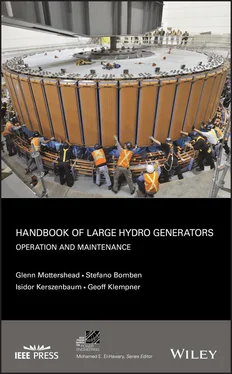1 Cover
2 Title Page
3 Copyright Page
4 Dedication Page
5 Preface
6 About the Authors
7 Acknowledgments
8 CHAPTER 1: Principles of Operation of Synchronous Machines 1.1 Introduction to Basic Notions on Electric Power 1.2 ELECTRICAL–MECHANICAL EQUIVALENCE 1.3 ALTERNATING CURRENT (AC) 1.4 THREE‐PHASE CIRCUITS 1.5 BASIC PRINCIPLES OF MACHINE OPERATION 1.6 THE SYNCHRONOUS MACHINE 1.7 SYNCHRONOUS MACHINE: BASIC OPERATION 1.8 REFERENCES 1.9 FURTHER READING
9 CHAPTER 2: Generator Design and Construction 2.1 STATOR CORE 2.2 STATOR FRAME 2.3 ELECTROMAGNETICS 2.4 CORE‐END HEATING 2.5 FLUX AND ARMATURE REACTION 2.6 STATOR CORE AND FRAME FORCES 2.7 STATOR WINDINGS 2.8 STATOR WINDING WEDGES 2.9 ENDWINDING SUPPORT SYSTEMS 2.10 STATOR WINDING CONFIGURATIONS 2.11 STATOR TERMINAL CONNECTIONS 2.12 ROTOR RIM 2.13 ROTOR SPIDER/DRUM 2.14 ROTOR POLE BODY 2.15 ROTOR WINDING AND INSULATION 2.16 AMORTISSEUR WINDING 2.17 SLIP/COLLECTOR RINGS AND BRUSH GEAR 2.18 COOLING AIR 2.19 ROTOR FANS/BLOWER 2.20 ROTOR INERTIA, TORQUE, AND TORSIONAL STRESS 2.21 THRUST AND GUIDE BEARINGS 2.22 REFERENCES 2.23 FURTHER READING
10 CHAPTER 3: Generator Auxiliary Systems 3.1 OIL SYSTEMS 3.2 STATOR SURFACE AIR COOLING SYSTEM 3.3 BEARING COOLING COILS AND WATER SUPPLY 3.4 STATOR WINDING DIRECT COOLING WATER SYSTEM 3.5 EXCITATION SYSTEMS 3.6 EXCITATION SYSTEM PERFORMANCE CHARACTERISTICS 3.7 REFERENCES
11 CHAPTER 4: Operation and Control 4.1 BASIC OPERATING PARAMETERS 4.2 OPERATING MODES 4.3 MACHINE CURVES 4.4 SPECIAL OPERATING CONDITIONS 4.5 BASIC OPERATION CONCEPTS 4.6 SYSTEM CONSIDERATIONS 4.7 GRID‐INDUCED TORSIONAL VIBRATIONS 4.8 EXCITATION AND VOLTAGE REGULATION 4.9 REFERENCES 4.10 FURTHER READING
12 CHAPTER 5: Monitoring and Diagnostics 5.1 GENERATOR MONITORING PHILOSOPHIES 5.2 SIMPLE MONITORING WITH STATIC HIGH‐LEVEL ALARM LIMITS 5.3 DYNAMIC MONITORING WITH LOAD VARYING ALARM LIMITS 5.4 ARTIFICIAL INTELLIGENCE (AI) DIAGNOSTIC SYSTEMS 5.5 MONITORED PARAMETERS 5.6 RADIO FREQUENCY MONITORING 5.7 CAPACITIVE COUPLING 5.8 STATOR SLOT COUPLER 5.9 ROTOR 5.10 EXCITATION SYSTEM 5.11 REFERENCES 5.12 FURTHER READING
13 CHAPTER 6: Generator Protection 6.1 BASIC PROTECTION PHILOSOPHY 6.2 IEEE DEVICE NUMBER 6.3 BRIEF DESCRIPTION OF PROTECTIVE FUNCTIONS 6.4 TRIPPING AND ALARMING METHODS 6.5 REFERENCES 6.6 FURTHER READING
14 CHAPTER 7: Inspection Practices and Methodology 7.1 SITE PREPARATION 7.2 EXPERIENCE AND TRAINING 7.3 INSPECTION FREQUENCY 7.4 GENERATOR ACCESSIBILITY 7.5 INSPECTION TOOLS 7.6 INSPECTION FORMS 7.7 REFERENCES
15 CHAPTER 8: Stator Inspection 8.1 STATOR FRAME SOLEPLATES 8.2 STATOR FRAME: GENERAL 8.3 STATOR CORE AIR DUCTS 8.4 STATOR CORE LAMINATIONS 8.5 STATOR CORE CLAMPING SYSTEM 8.6 STATOR COILS/BARS 8.7 FLOW RESTRICTION IN WATER COOLED STATOR WINDINGS 8.8 STATOR WEDGING SYSTEM 8.9 STATOR ENDWINDING 8.10 MAIN AND NEUTRAL END LEADS, CABLES, VTS, CTS, AND INSULATORS 8.11 REFERENCES
16 CHAPTER 9: Rotor Inspection 9.1 ROTOR SPIDER WITH SHRUNK LAMINATED RIMS 9.2 ROTOR RIM 9.3 ROTOR POLES 9.4 ROTOR BRAKES 9.5 REFERENCES 9.6 FURTHER READING
17 CHAPTER 10: Auxilliaries Inspection 10.1 EXCITATION: FIELD BREAKER 10.2 EXCITATION: STATIC EXCITER COMPONENTS 10.3 BRUSHLESS EXCITER 10.4 STATIC EXCITER TRANSFORMER 10.5 EXCITATION: ROTATING EXCITERS 10.6 EXCITATION: SLIPRINGS, COMMUTATOR, AND BRUSHES 10.7 SURFACE AIR COOLERS 10.8 FIRE PROTECTION 10.9 GENERAL ITEMS 10.10 THRUST AND GUIDE BEARING 10.11 MISCELLANEOUS AUXILIARIES 10.12 REFERENCES
18 CHAPTER 11: Maintenance and Testing 11.1 STATOR CORE MECHANICAL 11.2 STATOR CORE ELECTRICAL TESTS 11.3 STATOR WINDING MECHANICAL TESTS 11.4 STATOR WINDING ELECTRICAL TESTS 11.5 ROTOR MECHANICAL TESTING 11.6 ROTOR ELECTRICAL TESTING 11.7 BEARINGS 11.8 HEAT‐RUN TESTING 11.9 REFERENCES
19 CHAPTER 12: Maintenance Philosophies, Upgrades, and Uprates 12.1 GENERAL MAINTENANCE PHILOSOPHIES 12.2 OPERATIONAL AND MAINTENANCE HISTORY 12.3 MAINTENANCE INTERVALS/FREQUENCY 12.4 PLANNED OUTAGES 12.5 REHABILITATION, UPRATING/UPGRADING AND LIFE EXTENSION 12.6 EXCITATION SYSTEM UPGRADES 12.7 WORKFORCE 12.8 SPARE PARTS 12.9 EFFECT OF UPRATING ON GENERATOR LIFE 12.10 REQUIRED INFORMATION, TESTS AND INSPECTION PRIOR TO UPRATING/UPGRADING 12.11 MAINTENANCE SCHEDULE AFTER UPRATING 12.12 REFERENCES
20 Index
21 IEEE Press Series on Power Engineering
22 End User License Agreement
1 Chapter 1TABLE 1.3-1 A comparison of Case 1 and Case 2
2 Chapter 4TABLE 4.1-1 Rating quantities for generatorsTABLE 4.2-1 Generator operating modesTABLE 4.3-3 Table comparing information on capability curvesTABLE 4.4-1 Values of permissible I 2currentTABLE 4.4-2 Permissible ( I 2) 2 t in a generatorTABLE 4.6-1 Limiting observable temperature rises of indirectly cooled salient p...
3 Chapter 6TABLE 6.2-1 Generator protective device function numbersTABLE 6.4-1 Example of faults and protective actions taken
4 Chapter 10TABLE 10.10-1 Typical bearing lubricating oil specifications.
5 Chapter 11TABLE 11.5-1 Guidelines for DC voltages to be applied during insulation resistan...TABLE 11.5-2 Recommended minimum values of polarization index for insulation per...TABLE 11.5-3 KT versus temperature for “Thermoplastic” and “Thermosetting” stato...TABLE 11.7-1 Actual results from an impedance test.
1 Chapter 1 Figure 1.1-1 Representation of two magnetic poles of opposite polarity, with... Figure 1.1-2 Representation of two north poles and the magnetic field betwee... Figure 1.1-3 Representation of a “permanent magnet” showing the north and so... Figure 1.1-4 Representation of a magnetic field created by the flow of curre... Figure 1.1-5 Representation of a magnetic field produced by the flow of elec... Figure 1.1-6 Representation of a magnetic field produced by the flow of elec... Figure 1.1-7 Representation of a magnetic field produced by the flow of elec... Figure 1.1-8 Electricity. (I) Ionic clouds of positive and negative currents... Figure 1.2-1 Electrical–mechanical equivalence. Figure 1.3-1 A phasor E that can represent the voltage impressed on a circui... Figure 1.3-2 Alternating circuits (resistive). Figure 1.3-3 Alternating circuits (resistive‐inductive‐capacitive). Figure 1.3-4 Definition of the “power triangle” in a reactive circuit. Figure 1.3-5 Schematic of a simple system in one‐line form. Figure 1.3-6 Case 1. The load is purely resistive in this example, and the s... Figure 1.3-7 Case 2. The load is resistive and inductive in this example, an... Figure 1.3-8 The effect on the voltage drop as the circuit goes from lagging... Figure 1.4-1 Three‐phase systems. Schematic depiction of a three‐phase circu... Figure 1.4-2 A “wye‐connected” source feeding a “delta‐connected” load. Figure 1.5-1 Both forms of Faraday's basic law of electromagnetic induction.... Figure 1.5-2 The Ampere–Biot–Savart law of electromagnetic‐induced forces as... Figure 1.5-3 Lenz's law as it applies to electric rotating machines. Basic n... Figure 1.5-4 Principle of energy conversion as applicable to electric rotati... Figure 1.6-1 The hydroelectric generator from Lauffen, now in the Deutches M... Figure 1.6-2 “Growth” graph, depicting the overall increase in size over the... Figure 1.6-3 Synchronous machine construction. Figure 1.6-4 “Developed” view showing four‐poles, slots, and a section of th... Figure 1.6-5 Typical winding configurations. Figure 1.7-1 Production of stator rotating field. Figure 1.7-2 Phasor diagram of an unsaturated salient pole generator (laggin... Figure 1.7-3 Vector diagram of generator with a lagging power factor. Figure 1.7-4 Vector diagram of generator with a leading power factor. Figure 1.7-5 Steady‐state power angle characteristic of a salient pole synch... Figure 1.7-6 One‐line representation of the circuit shown in Figures 1.4-1 a... Figure 1.7-7 Steady‐state equivalent circuit of a synchronous machine. Figure 1.7-8 Steady‐state equivalent circuit and vector diagram. (a) Generat...
Читать дальше











